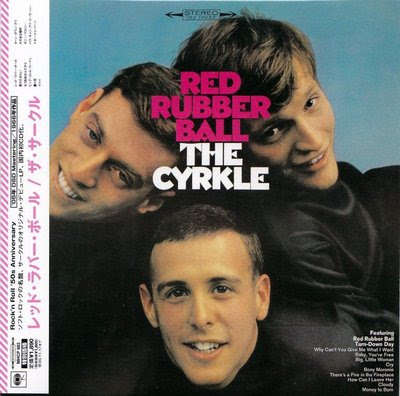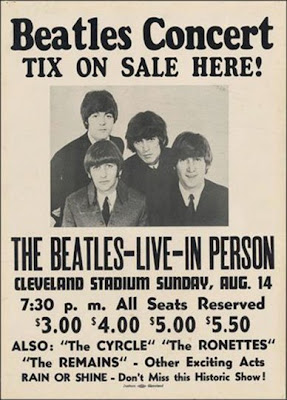The Cyrkle - Red Rubber Ball (SUNSHINE POP US 1966 JAPANESE Edition)
 "THE CYRKLE - RED RUBBER BALL" (SUNSHINE POP US 1966 JAPANESE Edition)
"THE CYRKLE - RED RUBBER BALL" (SUNSHINE POP US 1966 JAPANESE Edition)"The Cyrkle" are "Don Dannemann" (vocals, rhythm guitar), "Marty Fried" (drums, percussion), "Tom Dawes" (vocals, lead guitar, sitar, bass guitar) and "Jon Alexander" (keyboards).
"Don Dannemann" were both attending "Lafayette College" in Easton, PA, in 1961 when they decided to form a Frat-Rock band called "The Rhondells": they played mostly covers of current Pop/Rock hits by the "Four Seasons" and other top groups, as well as basic, dance-oriented Rock and Roll.
 The Cyrkle: "Red Rubber Ball" / "How Can I Leave Her", Columbia Records 43589, 1966
The Cyrkle: "Red Rubber Ball" / "How Can I Leave Her", Columbia Records 43589, 1966They were a cut above most other "Frat-Rock" bands, however, in the care they gave to those covers, which mostly grew out of "Tom Dawes"' and "Don Dannemann"'s respective ears for music.
Though officially the group's bassist, "Tom Dawes" could also analyze the interior structure of any vocal ensemble that he heard and also began writing songs after meeting "Don Dannemann", who was already writing songs when they met.
They were good enough to play some of the better rooms in Atlantic City, which was then a popular but somewhat declining East Coast resort.
While playing the "Alibi Lounge" during the summer of 1964, they were heard by "Nat Weiss", an entertainment lawyer and would-be music entrepreneur who suddenly became very prominent in 1964 when he hooked up with British manager "Brian Epstein".
He played a key role in getting "The Beatles" some prime gigs, including their "Carnegie Hall" and "Shea Stadium" concerts in 1964 and 1965, respectively.
In late 1965, "Nat Weiss" got seriously interested in the group and brought them to New York City to play some club dates in Greenwich Village.
The name "The Rhondells", with its early-'60s aura, was abandoned in favor of "The Cyrkle" (a name supposedly suggested by "John Lennon", whose advice was asked by "Brian Epstein" which was as clever a play on spelling as "The Byrds" (who were burning up the charts at the time) or, for that matter, "The Beatles".
"The Cyrkle" were heard there by "Barry Kornfeld", a musician and a friend of "Paul Simon", who was then belatedly enjoying a ride to the top of the charts with "Simon and Garfunkel" single "The Sound of Silence".
Just back from England and preparing to record an album, "Paul Simon" had a full songbag and not a lot of time.
As 1966 dawned, there was some interest gathering around "The Cyrkle" based on word-of-mouth from their shows, where they delivered a tight Folk-Rock sound.
Spending a couple of years of being a Rock and Roll band developing a tight sound, coupled with "Tom Dawes"' prior stint in a Folk band, paid off.
 The Cyrkle Poster live at Catacombs in Houston, Texas 01/27/1966
The Cyrkle Poster live at Catacombs in Houston, Texas 01/27/1966Also helping was "Nat Weiss"' hookup with "Brian Epstein"; at that time, any record label that could was trying to grab a piece of "Brian Epstein"'s action, based not only on the success of "The Beatles" but also that of "Gerry and The Pacemakers", "Billy J. Kramer and The Dakotas", and "Cilla Black", among others, all of whom were generating serious sales and major amounts of money.
Just at that moment, "Don Dannemann" was obligated to leave the band and civilian life for a short stint in the United States Coast Guard, which put the band on hiatus.
What seemed like an interruption in their momentum, however, became the source of one of the biggest breaks imaginable.
"Tom Dawes", left with nothing to do and having hooked up peripherally with "Simon and Garfunkel", signed on as bassist for "Simon and Garfunkel" on one of their tours. While playing with them, he got to hear just about all of "Paul Simon"'s songs that "Paul Simon" cared to utilize.
The duo's repertory was fairly thin, owing to their sudden success, including two numbers that "Paul Simon" had written in England with "Bruce Woodley" of "The Seekers", "Red Rubber Ball" and "Wish You Could Be Here".
"Red Rubber Ball" was recorded as soon as the quartet was back together, and with "Brian Epstein" and "Nat Weiss" exerting all of the pressure they could, got "Columbia Records" to sign "The Cyrkle" and release the single.
Issued in April of 1966, it rode the charts all that spring and got as high as number two, earning the group a spot on "The Beatles"' 1966 summer and subsequently, final scheduled, concert tour with another FANTASTIC 60s Garage group, "THE REMAINS".
The band members themselves, who had started doing this as a lark in college and, as recently as six months earlier had been playing Greenwich Village Folk clubs to audiences of a couple of hundred people, were astonished to find themselves suddenly thrust into the role of an arena act.
 Cleveland stadium concert Poster 08/14/1966:
Cleveland stadium concert Poster 08/14/1966: The Beatles, The Remains, The Ronettes and The Cyrkle
An LP, titled "Red Rubber Ball", was recorded that spring under producer "John Simon", utilizing the same lyrical Folk-Rock sound found on the 45 disc.
It rose to number 47 on the charts and a second single, "Turn Down Day", was issued in the early summer of 1966, reaching number 16 and thus completing the group's stay in the pop chart annals.
They continued despite several personnel changes, "Jon Alexander" left for medical school and was replaced by "Mike Losekamp", and a second album, Neon, appeared in 1967, though the cover of that record depicted the band as a trio.
see also "The Cyrkle - Neon" (Psychedelic Pop US 1967 Japanese Edition)
Subscribe to:
Post Comments
(
Atom
)








1 Comments :
thanks a million for this!
Post a Comment